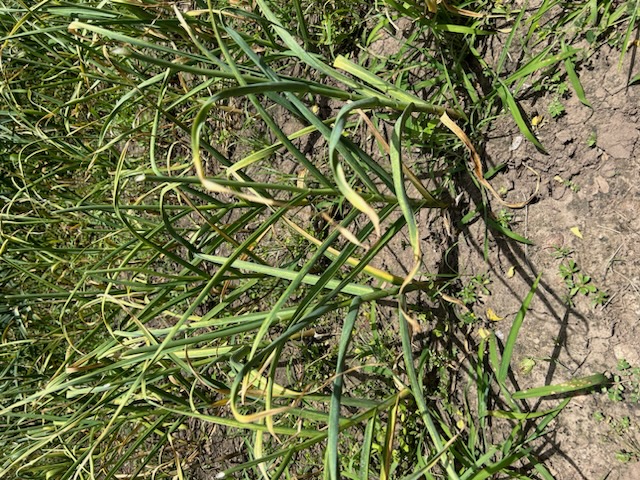Growing Garlic

Garlic is a relative of onions and chives that has been grown for centuries for both its culinary uses as well as its medicinal use. Each garlic will grow a bulb of several separate cloves. There are two different types of garlic that can be planted in the home garden. The first type is a soft neck garlic. This type of garlic has the longest storage life, forms bulbs with more cloves and they form a stalk that is easy to braid for storage. They do tend to have less flavor and be harder to peel than the other type but their shelf life makes up for it. Inchelium Red and Silver White are two soft neck varieties that do well in Kansas. Both varieties will store for 9 to 12 months. Inchelium red has a spicier flavor right after it’s been harvested but mellows with time while Silver White has a mild flavor when harvested that gets more bite as it ages. The other type of garlic is called hard neck garlic. This type is more flavorful, is easier to peel, have larger bulbs with fewer cloves however it doesn’t last as long when stored. Music and Chesnok Red are two varieties of hard neck garlic that do well in Kansas. Music has very large bulbs with big cloves. Both varieties will last about 4 to 6 months in storage. Hard neck varieties are hardier and tolerate colder temperatures than soft neck varieties however in Kansas we can successfully grow both types of garlic due to our fairly mild winters.
Garlic is best planted in mid to late October and then will be harvested in July. Be sure to purchase your garlic from a reputable source. It’s best to avoid planting garlic you bought from the grocery store. Separate each clove from the garlic bulb, be sure when you plant to put the pointy side up about 6 inches apart in rows that are spaced about 12” apart. Plant the garlic approximately 2” deep in the soil then cover the cloves with soil and mulch in to protect them from our freeze/thaw cycle in the spring. Be sure to water things in well and continue to water them throughout the fall into the winter if there isn’t any precipitation. It is possible to over water and rot the cloves so avoid overwatering. Fertilize the area with a general-purpose fertilizer if a soil test indicates it’s necessary.

Garlic will start to root once it’s planted and start to send up a shoot even if nothing is visible above the ground. Once the ground freezes the garlic will sit over winter and then emerge in the spring when the temperatures warm up. Continue watering the garlic as needed throughout the growing season until it’s close to time to harvest it. Garlic bulbs are ready to harvest when the lower third of the leaves have turned brown and dried out which typically is mid-July through early August depending on the variety. Picking garlic too early will result in small bulbs but waiting too long will result in cloves leaning away from the bulbs.
Garlic is a relatively easy plant to grow in the garden, just be sure to remember where you planted it so you don’t till the plants up or plant something over the top of them in the spring. It’s also important to remember to water them some throughout the winter if we have a dry winter.

Have questions? Contact our office where our Horticulture Extension Agent will assist you with questions.
Phone: (316) 321-9660
Email: callae@ksu.edu